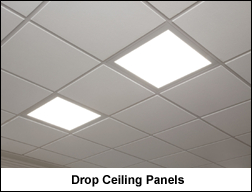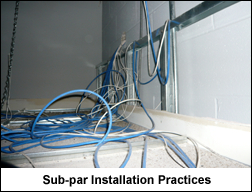What's Hiding Above Your Drop Ceiling?
Posted sometime prior to .

Have you ever taken a look at what lies above your drop ceiling panels (Fig. 1)? You should.
If your business premises is like the majority of others, you are likely to see a variety of cables (datacom, security system, etc.) draped on top of the ceiling panels, in a line-of-site manner, in an effort to save cable and installation effort. If you're really unfortunate, you'll find cables that are pulled tight (absence of slack).
When cabling is draped on top of ceiling panels, it is a hindrance to trade activities (datacom, electrical, HVAC, fire suppression). When panels are lifted, removed, or replaced by tradesmen, the cabling is subject to disturbance, and is at risk of being damaged by the sharp edges of the metal panel supports. If a cable is damaged, there is significant potential for loss of critical business functions. Imagine losing access to a critical database; the Internet, or a phone line, due to something as avoidable as poor cabling practices. Don't let this happen to you.
Your cabling should be supported every 3 – 4 ft. (at a minimum), throughout the cable run. Cabling should be routed through a pathway, about 6 in. above the ceiling panels, fastened to the walls. The pathway should accommodate a reasonable number of additional cable runs, to accommodate future needs. There are numerous products on the market, that can be utilized in a variety of ways, to define a suitable pathway for your cabling. Committing to such a process will keep your cabling out of harms way, and out of the way of your tradesmen.

Decommissioned cabling represents additional, undesirable fire load (combustible building contents), that should be removed from the premises. If you're installing a new cable plant, and don't plan to re-purpose the old one, remove the cabling, following a successful switch over.
There is no reasonable excuse for the line-of-sight, draping of cable on top of ceiling panels. Even less so, when there is no slack present in the cables installed this way. It is abundantly evident that left to the discretion of most installers, appropriate decisions will not be made; your best interests will fall to the wayside, and you'll never know about it, until it's too late.
If you're hiring tradesmen to install cabling, discuss their installation practices, before the job commences. If it becomes clear that their installation practices are sub-par (Fig. 2), hire someone else. It's your best defence.
last modified: 2025.09.02, 17:05 -0400
endeavor-networks.com/articles/what-is-hiding-above-your-drop-ceiling.shtml.en-CA
© 1999 – 2025 All rights reserved by the Domain Registrant.